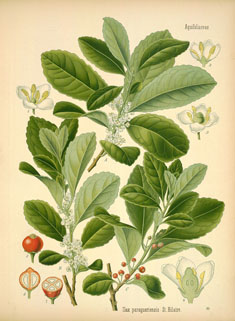Matey Yerba Mate
By Audrey Stallsmith

Amid those marshy woodlands far and wide
Which spread beyond the soaring vulture’s eye,
There grew on Empalado’s southern side
Groves of that tree whose leaves adust supply
The Spaniards with their daily luxury. . .
from "Yerba Mate" by Robert Southey
One of my favorite "energizing" beverages contains both black tea and the South American yerba mate. But I dip those tea bags in boiling water, which Brazilians and Argentineans would probably consider sacrilege!
In South America mate is brewed in hot, rather than boiling, water. The traditional "cup" is a calabash gourd that is packed about two thirds full with leaves. Then the hot water is added, along with a metal straw called a bombilla ("little pump"). The straw generally contains a strainer on its end to prevent the leaves from being sucked up along with the water.
This gourd is often passed around a circle of friends. The first person drinks off all the liquid and passes the container back to the host, who refills it with hot water. Then it proceeds to the next person in the circle. Although some North Americans might consider this ritual unsanitary, it reportedly promotes feelings of trust and belonging among the participants.
Pronounced mah-tay, after the Quechua mati ("gourd"), the herb is actually a type of holly, Ilex paraguariensis. (The accent mark, sometimes added to the e in mate, is generally only used in English-speaking cultures.) It has also been known as chimarrão, Paraguay tea, and Jesuit tea.
Although the bush can grow up to sixty feet or so, it is usually kept much smaller. It produces small yellowish green flowers and red berries about the size of peppercorns. Like most hollies, mate requires both male and female plants for the production of fruits. But the male are most used for tea, due to their stronger flavor. The herb is often dried over open fires, making its flavor somewhat smoky.
It has a rather sooty history as well, in that the Conquistadors originally enslaved the friendly Guarani people, who knew mate as caa ("the plant"), and forced them to gather it from the wild. As Southey wrote, "The poor Guaranies dreamt of no such ill,/ When for themselves in miserable hour,/ The virtues of that leaf, with pure good-will,/ They taught their unsuspected visitor."
The herb never became as popular as coffee or tea in the Old World, though. Eventually Jesuit missionaries taught the Guarani how to grow it on plantations, though their sales were mostly to other parts of South America. The Jesuits had learned that the very hard seeds germinate best after passing through the digestive systems of birds. They may have figured out some chemical way to duplicate this process. Or perhaps they fed the seeds to their chickens and "planted" the droppings! At any rate, that secret was lost for a time after the plantations were broken up.
Mate contains about the same amount of caffeine as tea, which makes it a mild stimulant. When combined with black tea, it probably approaches the levels of coffee. It contains theobromine as well, like chocolate does. Perhaps that's why mate also makes people feel more upbeat.
Providing a fair amount of Vitamin C, as well as several other vitamins, it probably helped prevent scurvy among the meat-eating gauchos. It is also a diuretic, and is said to improve digestion at the same time as it suppresses appetite. Mate can increase the risk of esophageal cancer in those who drink a lot of it. That could be due to the hot water rather than the leaves, however, as mate also kills some cancer cells.
It has been credited with preventing alcoholism in areas where it is most popular. So people who have a problem with intoxicants might want to give it a try instead. After all there aren't many beverages that can make you feel happy without the hangover!
Ilex paraguariensis image is from Kohler's Medizinal-Pflanzen, courtesy of the Missouri Botanical Garden.








